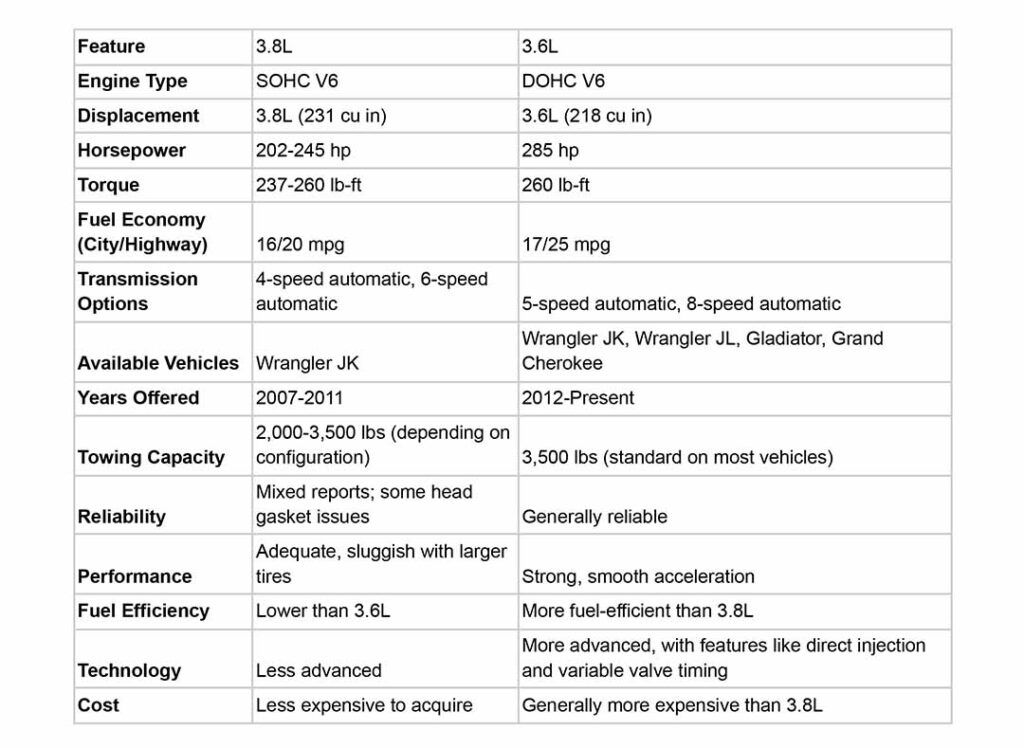Jeep 3.8L vs. 3.6L Engines [Pros, Cons & Key Differences]
Jeep enthusiasts often find themselves deciding between the Jeep 3.8 V6 engine and the Jeep 3.6 V6 engine.
The 3.8 engine, boasting 202 horsepower and a 3500-pound towing capacity, is a reliable and cost-effective option but with lower fuel efficiency.
On the other hand, the 3.6 engine offers a more robust 285 horsepower and a higher 4000-pound towing capacity, albeit at a higher cost.
When making the decision, it boils down to personal preferences and priorities.
If reliability, simplicity, and cost-effectiveness are key factors, the 3.8 engine might be the ideal choice. However, for those seeking greater power, towing capabilities, and modern features, the 3.6 engine comes into play.

In this comparison, I delve into the nuances of the Jeep 3.8 vs. 3.6 engines, exploring their strengths, drawbacks, and considerations that should guide your decision.
Table of Contents
Jeep 3.8L vs. 3.6L: What Are the Key Differences?

Power and Performance Analysis
When comparing the Jeep 3.6 V6 and the Jeep 3.8 V6 engines, there’s a notable difference in power.
The 3.6 engine boasts a higher output, producing 285 horsepower and 260 lb-ft of torque, while the 3.8 engine generates 205 horsepower and 240 lb-ft of torque.
Despite being more powerful, the 3.6 engine showcases better fuel efficiency, averaging around 16 miles per gallon in the city and 21 miles per gallon on the highway.
In contrast, the 3.8 engine, though less powerful, is less fuel-efficient, averaging around 15 miles per gallon in the city and 19 miles per gallon on the highway.
Off-Road Capabilities
The Jeep 3.6 and 3.8 engines are designed to handle challenging off-road conditions.
The 3.6 engine, with its higher horsepower and torque, stands out as a more robust choice for off-roading.
However, the 3.8 engine remains a capable off-roader, easily navigating most trails.
If extensive off-roading is in your plans, the 3.6 engine might be preferable.
Towing Capacity
In terms of towing capacity, the Jeep 3.6 engine takes the lead with an impressive 4,000 pounds, surpassing the 3.8 engine’s towing capacity of up to 3,500 pounds.
If your adventures involve towing heavy loads, the 3.6 engine becomes more suitable.
Cost Considerations
Cost consideration is crucial in deciding between the two engines. Generally, the Jeep 3.6 engine is priced higher than the 3.8 engine.
The specific model and trim level will influence the cost difference.
If cost is a significant factor for you, the Jeep Wrangler 3.8 engine presents a good balance of performance and affordability.
Jeep 3.8L vs. 3.6L: What Similarities Do They Have?
When exploring the Jeep 3.8 and 3.6 engines, you’ll discover several shared characteristics contributing to the iconic Jeep experience.
Solid Design
The 3.8 and 3.6 engines boast a robust and solid design, aligning perfectly with the Jeep’s reputation for on and off-road prowess.
These engines have been in the Jeep lineup for years, and the little rough edges they had have been smoothed over.
These engines offer the right build capacity to handle challenging terrains, ensuring durability and reliability.
Compatible Style
The classic and iconic style of the Jeep is a hallmark shared by both the 3.8 and 3.6 engines.
With recognizable features like the removable doors, roof, round headlights, and the distinctive seven-slot grille, these engines seamlessly integrate with the Jeep’s timeless design.
Four-Wheel Drive (4WD) System
Enjoy the capability to tackle rough terrains with the shared four-wheel drive systems in the 3.8 and 3.6 Jeep engines.
These systems contribute to reliable performance on various surfaces because they are engineered to enhance traction and stability.
Highly Convenient
Experience convenience at its finest with the smartphone connectivity systems present in both engines.
These systems improve navigation and feature advanced audio options.
Safety Features
Safety takes the forefront in the 3.8 and 3.6 engines equipped with advanced safety features.
From stability control to anti-lock brakes and airbags, these engines prioritize the well-being of both driver and passengers, providing reassurance during your travels.
Comparing the Pros and Cons of Jeep’s 3.8L and 3.6L Engines
Jeep 3.8L Engine
Pros
- Reliable Performance: The 3.8 engine’s fewer components contribute to stable performance, ensuring reliability on and off challenging terrains.
- Cost-Effective: Opting for the 3.8 engine proves to be a more budget-friendly choice, whether during the initial purchase or subsequent repairs.
Cons
- Less Powerful: With 202 horsepower, 237 lb/ft traction, and a towing capacity of 3500 pounds, the 3.8 engine falls short in power when compared to the 3.6 engine.
- Less Fuel Efficiency: Compared to the 3.6 engine, the 3.8 engine exhibits relatively lower fuel efficiency.
Jeep 3.6L Engine
Pros
- Better Off-Road Performance: The 3.6 engine provides excellent stability on and off the road, efficiently handling rough terrains.
- More Powerful: The standout feature of the 3.6 engine lies in its impressive power components, delivering a robust and reliable performance.
- Better Towing Capacity: Boasting a towing capacity of up to 4000 pounds, the 3.6 engine surpasses the 3.8 engine in handling heavier loads, even on rough terrains.
- Fuel Efficiency: Whether navigating city streets or cruising on the highway, the Jeep 3.6 demonstrates better fuel efficiency than its counterpart, the 3.8 engine.
Cons
- Expensive: A notable drawback of the Jeep 3.6 engine is its higher cost in terms of initial purchase and repairs.
Also Read: Jeep Willys vs. Willys Sport – Unveiling the Key Differences
Choosing Between the Jeep 3.8L V6 and 3.6L V6: A Guide to Your Ideal Pick
Choosing between the Jeep 3.8L and Jeep 3.6L depends on your priorities and preferences. Here’s a breakdown of factors to consider:
Reasons to Choose the Jeep 3.8 Engine
- Solid and Reliable: The 3.8 engine has been in production for many years and is known for its reliability. If you’re looking for a proven and sturdy engine, especially for off-road use, the 3.8 is a solid choice.
- Cost-Effective: In terms of both initial purchase and repairs, the 3.8 engine tends to be more budget-friendly than the 3.6.
- Simpler Design: The 3.8 engine has a simpler design, making it easier to work on and maintain. If you prefer a straightforward engine that’s less complicated to service, the 3.8 is a good fit.
Reasons to Choose the Jeep 3.6 Engine
- More Power: The 3.6 engine offers higher horsepower (285 HP) than the 3.8 (202 HP). If you prioritize performance and want a more powerful engine, especially for towing or off-road adventures, the 3.6 is superior.
- Better Fuel Efficiency: The 3.6 engine tends to be more fuel-efficient than the 3.8. If fuel economy is important to you, especially for daily commuting or long trips, the 3.6 might be a better choice.
- Modern Technology: The 3.6 engine features modern technology, including DOHC, VVT, and a more advanced design. While this makes it more complex, it also improves performance and efficiency.
- Improved Transmission: If you opt for an automatic transmission, the 5-speed auto for the 3.6 is considered vastly better than the one that came with the 3.8. This can enhance your overall driving experience.
Things to Consider for You Before Buying a Jeep
Model Year: The 3.6 was introduced in 2012. If you prefer a newer engine with updated features, the 3.6 is the way to go.
Budget: Consider how much you will need to spend on the initial purchase as well as any necessary maintenance.
The 3.8 might save you money upfront, but the 3.6 could offer better long-term performance and efficiency.
If you prioritize reliability, cost-effectiveness, and simplicity, the 3.8 is a reasonable choice.
If you lean towards more power, better fuel efficiency, and modern technology, the 3.6 is a superior option.
Take a test drive with both engines to help you decide which one best suits your needs and driving style.
In my opinion, if you have a Jeep 3.6 or 3.8 already, don’t bother to change. It’ll not be cost-effective.
However, if you are buying a Jeep and don’t already have one, go for the Jeep 2013 3.6L V6. It’s your best option.
On the other hand, if you are hell-bent on a 3.8, go for Jeep 2011 3.8 V6. It’s the best option for you.
Read More: Sahara Altitude Vs. High Altitude: Unveiling The Key Differences
Final Words
Choosing between the Jeep 3.8 and 3.6 engines depends on your priorities.
The 3.8 offers proven reliability, simplicity, and cost-effectiveness.
In contrast, the 3.6 provides enhanced power, improved fuel efficiency, modern technology, and an upgraded transmission.
Consider your budget, desired performance, and preference for off-roading when deciding.
